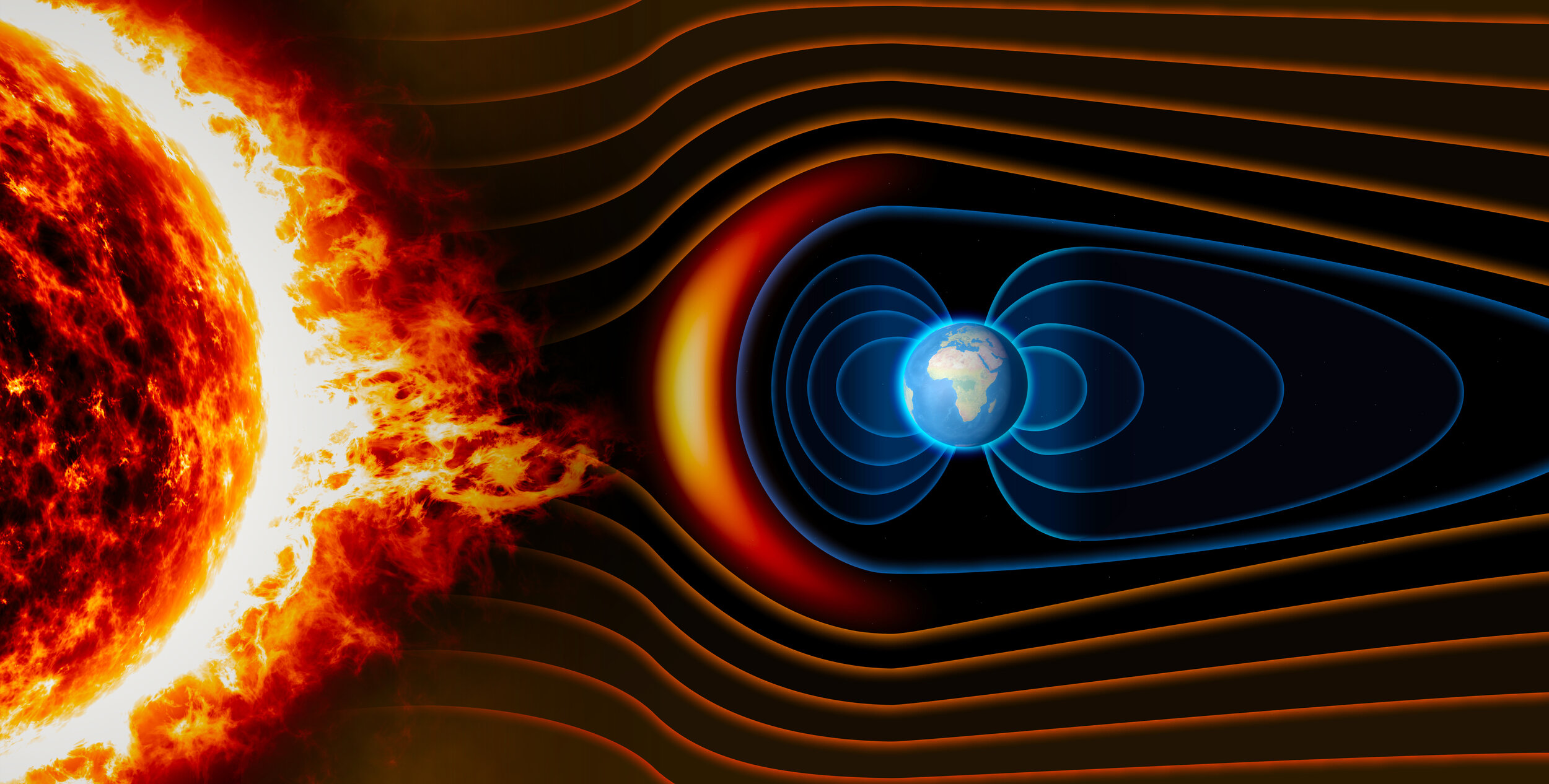
Intelligent Design and Fine Tuning
Life in the Universe
The illustration above shows how the global magnetic field of the earth deflects energetic charged particles from the sun. Without this field, the radiation environment on the earth would be toxic to living organisms. This is an example of God’s grand design for a life-permitting planet. Licensed by Shutterstock.
The Origin and Evolution of Life
Modern astronomy shows the universe had a beginning. Life had to arise in the universe either from non-living matter by natural processes alone, or by intelligent causation.
Microevolution is a blind and mindless process through which random mutations of an existing organism produce changes over many generations of reproduction, resulting in variations such as races within the species. Some of the traits arising from microevolution may lead to improved survivability of the descendants. That is what occurs in natural selection. Microevolution explains the emergence of variations within species, but it cannot explain the emergence of new species.
Macroevolution is the arrival of new and more-complex species. It assumes gradualism, where many small and gradual changes occur over a long period of time (microevolution), resulting in the emergence of new species, causing complex organisms to arise from simple organisms. If macroevolution really happened, the fossil record should reveal appearances of intermediate transitional species. However, the fossil record shows most species did not arise gradually by transformation of ancestors. They appeared fully formed. That is known as sudden appearance. Most species in the fossil record show limited change throughout their existence, from first appearance through disappearance. That is known as stasis. The fossil record does not support macroevolution.
Belief in a God who designed, created, and planted living organisms on the earth is compatible with the evidence of the fossil record. Belief in created organisms is consistent with sudden appearance and stasis. God could have created fully formed species and could have planted them throughout the earth. That could explain sudden appearances. The fully formed species can transform by microevolution, with all descendants remaining within the same species, but with some variations, such as color and race.
Modern evolutionary theory, based on random mutations, presupposes the existence of the mutating gene, and therefore cannot explain the origin of the first living organism. It becomes necessary to believe non-life produced life. Everyday observation shows that only existing life produces life. Evolution may be an adequate theory of transformation of existing life, but it is not an adequate theory of appearance of the first living organism, and it is not an adequate theory of appearance of more-complex organisms.
Evolutionary theory cannot explain the irreducible complexity of living organisms. The principle of irreducible complexity states that a functioning system cannot be reduced further below the level of its critical components and the proper integration between them. Living organisms exhibit irreducible complexity. It is extremely unlikely that precursors to living organisms evolved through gradual random changes into irreducibly complex living organisms. A precursor to an irreducibly complex system could not be fully functional, and therefore is unlikely to randomly evolve into a working irreducibly complex system.
Evolutionary theory cannot explain the specified complexity of living organisms. Specified complexity entails both complex structure and the specification of a message. The DNA molecule (Figure 1), present in all living matter, is complex and specified.
Figure 1. The DNA molecule exhibits specified complexity, which is indicative of intelligent design. Image provided by Zephyris. Licensed under the Creative Commons Attribution-Share Alike 3.0 Unported license.
In addition to its complex and well-ordered structure, the DNA molecule has a coded message in its nucleotide sequence. The coded message contains instructions for the assembly of proteins. The presence of specified complexity suggests an intelligent cause. Since all living organisms have DNA, they all exhibit specified complexity. Since the presence of specified complexity suggests intelligence, it is reasonable to conclude life was intelligently caused.
The Earth as a Privileged Planet
A life permitting planet must move in a stable orbit within a habitable zone around a life-supporting star, as indicated for the earth in Figure 2. A habitable zone is a necessary condition to support life, but it is not sufficient. Scientists identified many other variables that impact a planet’s ability to support life. Significant variables include (but are not limited to) geological processes, magnetic field evolution, climate, chemical composition of the atmosphere, atmospheric escape, rotational effects, tidal forces, orbits, star formation and evolution, unusual conditions like binary star systems, gravitational perturbations from passing bodies, and the space radiation environment. Those variables in turn depend on other variables.
Figure 2. Habitable zone for the earth in orbit around the sun. (Note the scales are not linear.) Licensed by Shutterstock.
There are many conditions that must be met to permit the existence and endurance of life on a planet. They must all be compatible in the same solar system at the same time. The likelihood of meeting all of these conditions by chance alone anywhere in the universe is extremely slim. All things considered, the probability of having a life permitting planet orbiting a life supporting star in a stable orbit within a significant habitable zone in a safe radiation environment, along with meeting all the other known criteria, is exceptionally low. There are just too many conditions that need to be met, and some of them may have narrow ranges. Are we here because we just got very lucky, or are we here by design and with purpose? It is more reasonable to believe we are here by design and with purpose than to believe we are here by chance and without purpose. Our earth is a privileged planet, not by chance but by design.

